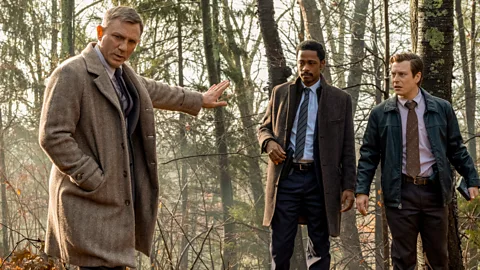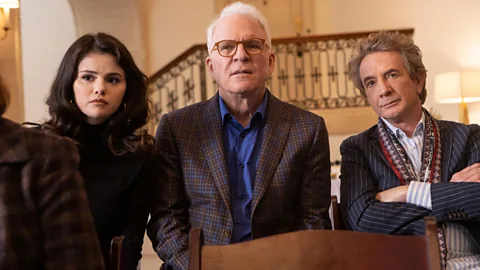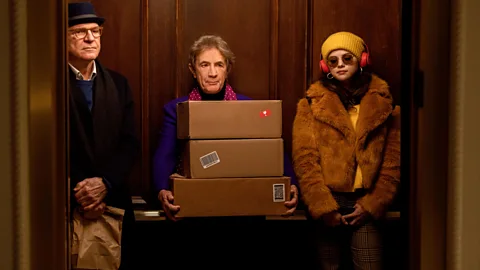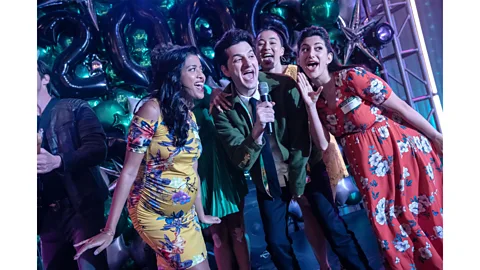The Afterparty: The reinvention of the murder mystery
 Apple TV+
Apple TV+The Afterparty is the latest show to reimagine the whodunnit for a new generation of armchair detectives, writes Clare Thorp.
A party in a lavish setting. A group of wildly different personalities. And then… a dead body, a room full of suspects, countless motives – and an inimitable detective determined to get answers. On the surface, new murder-mystery series The Afterparty feels reassuringly familiar. But – in true whodunnit fashion – nothing is entirely as it seems in Apple TV+'s new show, which is both a classic murder mystery, a riotous comedy – and something entirely new.
More like this:
- The 100 greatest TV series of the 21st Century
The show centres around a 15-year high-school reunion that ends with a VIP afterparty in a cliffside mansion – and a body at the bottom of the rocks. The cast includes Tiffany Haddish as the detective, Dave Franco as the victim (no spoilers – his death kicks off the whole show), and a gaggle of former classmates – and suspects – played by an impressive collection of comic talent, including Ben Schwartz (Parks and Recreation), Ilana Glazer (Broad City), Sam Richardson (Veep) and Jamie Demetriou (Stath Lets Flats).
In a bold move by creators Phil Lord and Chris Miller – the team behind The Lego Movie and Spider-Man: Into the Spider-verse – each suspect gets not just their own episode, but their own genre too. Depending on whose version of events we are seeing, the story is told as a rom-com, a musical, a psychological thriller, an action movie, a high-school movie, a gritty cop show and even an animation, with the camera techniques, lighting, music and direction to match. "For my whole life, I have loved watching Columbo and Murder She Wrote, reading all the Agatha Christie books, and doing crossword puzzles, acrostics, and hidden-word things," says Chris Miller in the show's production notes. "So to be able to do a comedy version of a whodunnit has been a real dream come true."
 Apple TV+
Apple TV+The show is inventive, chaotic and a lot of fun. It's also the latest in a new wave of murder mysteries on the big and small screen that are reinventing the genre for a new generation of armchair detectives. The Afterparty comes on the heels of last year's Only Murders in The Building, a ten-part whodunnit that paired comic stalwarts Steve Martin and Martin Short with Selena Gomez as three true-crime podcast fans who team up to solve a murder in their apartment block – and launch their own podcast about it. The show was a critical hit (scoring a 100% rating on Rotten Tomatoes), became Hulu's most-watched comedy ever in the US, and has a second season on the way. This month, Murderville – based on the BBC show Murder in Successville – comes to Netflix. It sees Will Arnett play a detective ed by a succession of celebrity guests (including Annie Murphy, Sharon Stone, Conan O'Brien and Kumail Nanjiani) to solve murders – the twist being the star guests have no script and have to improvise.
There are more in the works, too. The next show from The OA creators Brit Marling and Zal Batmanglij will be a "radical conceptualisation of the classic whodunnit", set at a billionaire's remote retreat and starring Emma Corrin (The Crown) as an amateur sleuth. On the big screen, a glossy new adaptation of Agatha Christie's Death on the Nile – its release delayed after controversy surrounding one of its stars, Armie Hammer – is released this month. And later this year there will be a sequel to Knives Out – the film that, arguably, led the way for this new wave of murder mysteries.
 Lionsgate
LionsgateReleased in 2019, Rian Johnson's take on a classic whodunnit gathered an impressively starry ensemble cast – including Daniel Craig as detective Benoit Blanc, alongside Jamie Lee Curtis, Chris Evans, Ana de Armas, Christopher Plummer, Toni Colette, Don Johnson and Lakeith Stanfield. Critics loved it – but it was at the box office that Knives Out made the most impact, taking more than $300million, and becoming the second most successful original film (neither an adaptation nor a sequel) that year.
In a movie industry that leans heavily on franchises and reboots for its big-hitters, Knives Out showed that fresh stories – albeit ones inspired by old favourites – could still be a huge success. So much so that Netflix paid $469million for the rights to two sequels, each of which will see Daniel Craig's Benoit Blanc return to investigate a new crime, with a brand new ensemble cast each time. The name is now Blanc, Detective Blanc.
Knives Out came two years after Kenneth Branagh's adaptation of Agatha Christie's Murder on the Orient Express, also a huge box-office hit, proved that whodunnits – especially star-studded ones – were still a draw. But Johnson didn't just jump on the murder mystery bandwagon. He'd had the idea for Knives Out nearly a decade earlier and, while a huge fan of the genre, he wanted to do more than just pay homage to it. "When you see a whodunnit, you tend to see it as a period piece, because it's usually an Agatha Christie adaptation," he told The Atlantic. "So the idea of doing an original one and setting it in the America of 2019 – not just giving it a modern skin but really plugging into today – there was something about that that seemed genuinely exciting."
For writers and directors, a modern murder mystery is an alluring prospect. "Over the last decade there have been crime-fiction writers who have said the whodunnit is dead, and the reason they think that is because we've run out of clever plots," says Dr Benedict Morrison, lecturer in literature, film and television at the University of Exeter. "There's no other way to get out of a locked room that hasn't already been done. There's no way of breaking an alibi that hasn't already been done. So I think it is really an exciting challenge that a creator takes on – not only to be sufficiently crafty to get one over on the viewer or the reader, but also to find something that actually feels fresh."
Morrison thinks the latest breed of whodunnits, for all their modern twists, stay surprisingly faithful to the spirit of the classic murder mystery in both their wit and their subtle examination of social issues. "We might encounter Christie now, and think her work is dated, but at the time she was reflecting on very contemporary concerns," he says. "Only Murders in the Building is engaged with contemporary technology and this kind of strange fetishisation of crime that occurs through podcasts. It's exploring that, but not in a heavy-handed way." It also features one of last year's most creative moments of television – a dialogue-free episode that centres around a deaf character.
 Hulu
HuluIn Knives Out, there are plenty of laughs and a compelling puzzle to solve – but Johnson also addresses inherited wealth, white privilege, the treatment of immigrants and liberal hypocrisy, creating a sharp social satire. "The way in which we see how class still operates in contemporary society – that's exactly the kind of social politics which has always been explored in the genre," says Morrison. What makes the whodunnit so suited for examining these issues? "The simplest answer is that at the heart of it is a puzzle about a violent crime, so to some extent questions of guilt, of shame, of culpability, of exploitation, of violence… these things are already baked into the form." Morrison says the very nature of a murder mystery – which encourages the audience to engage their brain to solve the puzzle – helps, too. "Our principal engagement with it is intended to be intellectual rather than emotional – it encourages us to think through things and to try to get to the bottom of what people's real relationships are with each other."
Tricks of the mind
Working those brain cells is one of the purest pleasures of watching a murder mystery, as us viewers find ourselves in competition with the detective to decipher the clues and identify the killer. For The Afterparty, Miller and Lord worked with magician and puzzle creator David Kwong and puzzle master Dave Shukan to make their mystery as fun as possible for fans. "In every episode, we've hidden a bunch of coded messages that are extra bonus hints for who did it," says Miller. "In the set dressing there are all these hidden things and if you freeze-frame you can decode hidden messages."
Originally written as a 90-minute film, Miller expanded his idea into a series to sustain the story over a longer period. Episodic television offers something films cannot – the chance for fans to share their theories – in person, on social media or on Reddit – as the show progresses, building excitement and anticipation. Like Only Murders in The Building, The Afterparty will – after an initial three-episode drop – release new episodes weekly. "Taking advantage of this serial form for the murder mystery is really smart and hasn't been done that often in the past," says Morrison.
Another delight of the whodunnit is watching the combined charisma of a starry ensemble cast, who each get their chance to shine. Actors often play against type – a cinematic sweetheart becomes an evil villainess, superheroes become murder suspects. Clever casting plays with our expectations of characters (Marvel's crime-fighting Captain America, aka Chris Evans, couldn't really be the conniving killer in Knives Out… could he?).
 Hulu
HuluIn Only Murders in The Building – nominated for a SAG award for Best Comedy Ensemble – the generational divide between Steve Martin and Martin Short, and Selena Gomez, provided plenty of funny moments – but also a surprising and charming friendship that was the backbone of the show. Gomez's performance was a revelation – and it couldn't hurt that she has nearly 300 million followers on Instagram, helping the show draw in a younger audience.
"There's a line in Murder on the Orient Express [the book] where Poirot is talking about how on a train you get this extraordinary collection of different kinds of characters, the old and the young, the rich and the poor and so on," says Morrison. "Whodunnits are very good at finding ways to show these interactions between very different types of personality but also very different types of kind of social position. It's why they're so good at talking about things like class and gender and sexuality."
It helps that the actors seem to be having as much fun playing these parts as we are watching them. In Knives Out, Daniel Craig sports an exaggerated southern drawl, sings along to Stephen Sondheim and is clearly loving every moment. Tiffany Haddish recalls in The Afterparty's production notes that when her agent said Lord and Miller wanted her to star in the show: "They said it's a mystery show where you solve cases, a whodunnit like Clue, and I was like, that's my game. Let's go!"
Tiffany Little Canfield, casting director of Only Murders in The Building, says the genre is inherently attractive to actors. "A murder mystery implies that you have several suspects, and when you are a suspect, the writers want to lead the audience on that you could be the killer," she tells BBC Culture. "So those parts always have mystery. They always have a secret. The actors know that even if they aren't the killer, they're probably still going to have some meaty writing. Even the little tiny parts, they've got something really delicious about them. It's a casting director's dream to work on something like that."
It means even a ing role in a murder mystery is catnip – and Canfield has fielded calls from agents keen to make it known that their clients are fans of the show and would relish a guest role. The time commitment is low but the pay-off is huge, says Canfield. "You get to show up for a couple of days or an episode and have a great part." The first season of Only Murders in the Building had memorable cameos from Sting and Tina Fey – and Shirley Maclaine and Amy Schumer are lined up for the next series (with Cara Delevingne ing as a recurring character).
 Apple TV+
Apple TV+The new breed of murder mysteries gives us irresistible all-star casts, sharp humour and an opportunity to divert ourselves with communal puzzle-solving. At a time when many of us would like to escape reality, it makes sense that there's a demand for them. "The moments when murder mysteries have really done huge business, both in of literature and cinema, have tended to coincide with moments of quite considerable social and political strain," says Morrison.
He thinks there is something more at play, though. "I've never entirely been sold on the murder mysteries-as-escapism idea. Instead, I think this is a safe and managed way to think about some of the questions that are facing society." He points out that the murder mystery in its classic form first flourished after World War One, with Christie's first published novel, The Mysterious Affair at Styles, published in 1920. "We also saw a massive rise in the number of film whodunnits in the post-World War Two period."
In some ways, it seems counterintuitive that a society coming to with loss on such a scale should invest in a genre all about death. "But actually, murder mysteries are about finding a certain kind of meaning within it," says Morrison. "I personally don't think that order is totally restored at the end of a murder mystery. There's always a kind of residual anxiety. But nevertheless, we feel in some way we've understood the meaning of this particular death." In uncertain times, it's comforting to have some answers. Not to mention the delicious satisfaction that comes if we manage to crack the code and beat the detective to it.
Love film and TV? BBC Culture Film and TV Club on Facebook, a community for cinephiles all over the world.
If you would like to comment on this story or anything else you have seen on BBC Culture, head over to our Facebook page or message us on Twitter.
And if you liked this story, sign up for the weekly bbc.com features newsletter, called The Essential List. A handpicked selection of stories from BBC Future, Culture, Worklife and Travel, delivered to your inbox every Friday.
